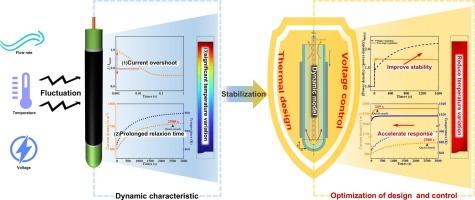Regulation of dynamic characteristics towards working fluctuation in ammonia solid oxide fuel cells for stable power generation
IF 10.9
1区 工程技术
Q1 ENERGY & FUELS
引用次数: 0
Abstract
Adapting to fluctuations in grid demand and fuel supply in direct ammonia solid oxide fuel cells (DA-SOFCs) is critically important yet highly challenging in hybrid energy systems. In this work, a high-resolution dynamic model was developed and validated with experiments to provide an in-depth understanding of the dynamic characteristics of tubular DA-SOFCs. The results reveal that ammonia decomposition increases complexity to the heat sources and distorts the distribution of species concentrations within the anode. Consequently, DA-SOFCs exhibit more pronounced relaxation times, current overshoot, and temperature variations under dynamic operating conditions. Enhanced thermal coupling between ammonia decomposition and electrooxidation through flow design reduces relaxation time by approximately 80% and temperature fluctuations by over 60%. A heat-transfer-based correlation is established to allow fast estimation of relaxation time. Extending the voltage ramp time to the ammonia mass transfer time substantially mitigates current overshoot. Furthermore, coordinated voltage and flow rate regulation on different time scales (seconds and minutes) enables fast and stable load tracking, effectively reducing power deviation from over 30% to less than 3%. These insights into the dynamic behavior of DA-SOFCs contribute to their flexible and durable operation in practical applications.

氨固体氧化物燃料电池稳定发电动态特性对工作波动的调节
在混合能源系统中,直接氨固体氧化物燃料电池(DA-SOFCs)适应电网需求和燃料供应的波动至关重要,但也极具挑战性。在这项工作中,开发了一个高分辨率的动态模型,并通过实验进行了验证,以深入了解管状da - sofc的动态特性。结果表明,氨分解增加了热源的复杂性,并扭曲了阳极内物质浓度的分布。因此,在动态操作条件下,da - sofc表现出更明显的松弛时间、电流超调和温度变化。通过流动设计增强了氨分解和电氧化之间的热耦合,使松弛时间减少了约80%,温度波动减少了60%以上。建立了基于传热的相关性,以便快速估计松弛时间。将电压斜坡时间延长到氨传质时间大大减轻了电流超调。此外,在不同时间尺度(秒和分)上协调电压和流量调节,实现快速稳定的负载跟踪,有效地将功率偏差从30%以上降低到3%以下。这些对da - sofc动态行为的见解有助于其在实际应用中的灵活和持久运行。
本文章由计算机程序翻译,如有差异,请以英文原文为准。
求助全文
约1分钟内获得全文
求助全文
来源期刊

Energy Conversion and Management
工程技术-力学
CiteScore
19.00
自引率
11.50%
发文量
1304
审稿时长
17 days
期刊介绍:
The journal Energy Conversion and Management provides a forum for publishing original contributions and comprehensive technical review articles of interdisciplinary and original research on all important energy topics.
The topics considered include energy generation, utilization, conversion, storage, transmission, conservation, management and sustainability. These topics typically involve various types of energy such as mechanical, thermal, nuclear, chemical, electromagnetic, magnetic and electric. These energy types cover all known energy resources, including renewable resources (e.g., solar, bio, hydro, wind, geothermal and ocean energy), fossil fuels and nuclear resources.
 求助内容:
求助内容: 应助结果提醒方式:
应助结果提醒方式:


